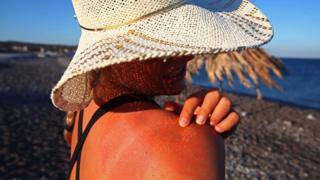
Image copyright
Getty Images
People are getting less than half the sun protection they expect from suntan lotions, according to research.
But the problem isn’t the lotion, it’s our slapdash application of it, King’s College London scientists say.
In theory, using sun protection factor (SPF) 15 sunscreen should be enough to stop sun damage.
But in reality, people need SPF 30 or 50 to be safe, say the study authors, who carried out experiments with volunteers in their lab.
It comes as temperatures are set to reach 33C in London on Thursday afternoon amid reports of the heat placing a strain on some health services.
Image copyright
Getty Images
Nick Scriven, president of the Society of Acute Medicine, said one doctor had told him their hospital had been busy at the weekend, with patients needing treatment for conditions linked to dehydration, including chest and urine infections.
Kim Sunley, national officer at the Royal College of Nursing, said nurses had reported temperatures in excess of 30C on some hospital wards.
She told the BBC: “We know wards are reaching over 30C, nurses are feeling sick, dizzy, having problems with their concentration.
“And that then does have an impact on how they care for their patients, making decisions around drugs calculations and just generally doing a physical occupation.”
Visits to the NHS Choices website for heat-related health advice so far this month are up nearly 450% compared to July last year.
- How does sunscreen work?
- Sun cream: ‘It takes two to do it properly’
- Water-resistant sunscreen claims ‘meaningless’
- Suntans on children ‘are not healthy’
How to apply it
Factor 50 lotion applied in the typical way would, at best, provide 40% of the expected protection, said Prof Anthony Young, whose team measured how much protection people got from wearing different amounts of suntan lotions with varying SPF strengths.
Sunscreen needs to be applied thickly enough, which many of us fail to do.
SPF ratings are based on the assumption that a 2mg blob will cover 1 sq cm of skin.
That means you should apply at least six full teaspoons (36g) to cover the body of an average adult.
More than half a teaspoon to:
- each arm
- the face, neck and ears
More than one teaspoon to:
- each leg
- chest and abdomen
- back
Areas such as the sides of the neck, temples and ears are commonly missed, so take extra care and apply liberally.
It is also easy to forget to reapply sunscreen as often as necessary.
The British Association of Dermatologists advises:
- Put it on 15 to 30 minutes before going out in the sun, to allow it to dry
- Top up again shortly after heading outdoors, to cover any missed patches and ensure you’re wearing a sufficient layer
- Reapply at least every two hours and immediately after swimming or if it has rubbed off
Some lotions say they are water resistant, meaning they retain some sun protection properties after immersion.
However, up to 85% of a product can be removed by towel drying, so you should reapply after swimming, sweating, or any other vigorous or abrasive activity.
Another important factor is the reflection of the Sun’s rays, which can greatly increase the power of the radiation: snow by up to 85% increase, sand by up to 17% and water by up to 5%.
What to do if you get sunburnt?
Image copyright
Getty Images
- Get out of the sun as soon as possible and head indoors or to a shady area
- Cool your skin with a cold bath or shower, wet sponge or cold flannel
- Use lotions containing aloe vera to soothe and moisturise the burned skin
- Drink plenty of fluids to cool down and prevent dehydration
- Take painkillers, such as ibuprofen or paracetamol, to relieve pain
- Cover up the affected areas of skin until it has fully healed
- Seek medical advice if you have blistering, chills, a fever or dizziness
Source: NHS Choices
People with fair skin that burns easily, many moles or freckles, red or fair hair and light-coloured eyes are most at risk of sun damage.
Sunscreens should not be used to stay outside longer or just to avoid more reliable protective measures such as clothing and shade.
Nina Goad, of the British Association of Dermatologists, said: “This research demonstrates why it’s so important to choose an SPF of 30 or more.
“It also shows why we shouldn’t rely on sunscreen alone for sun protection, but we should also use clothing and shade.”
- Sizzling 76: Shorts, standpipes, sunglasses
- How long will it last? Your heatwave questions
- Are your work clothes making you hotter?
The heatwave is set to continue across many parts of the UK this week.
Public Health England advises people try to keep cool and take shelter.
“To beat the heat, try to keep out of the sun from 11:00 to 15:00, walk in the shade if you can, apply sunscreen and wear a hat if you have to go out in the heat,” it says.
“Also try to carry water with you when travelling.”



